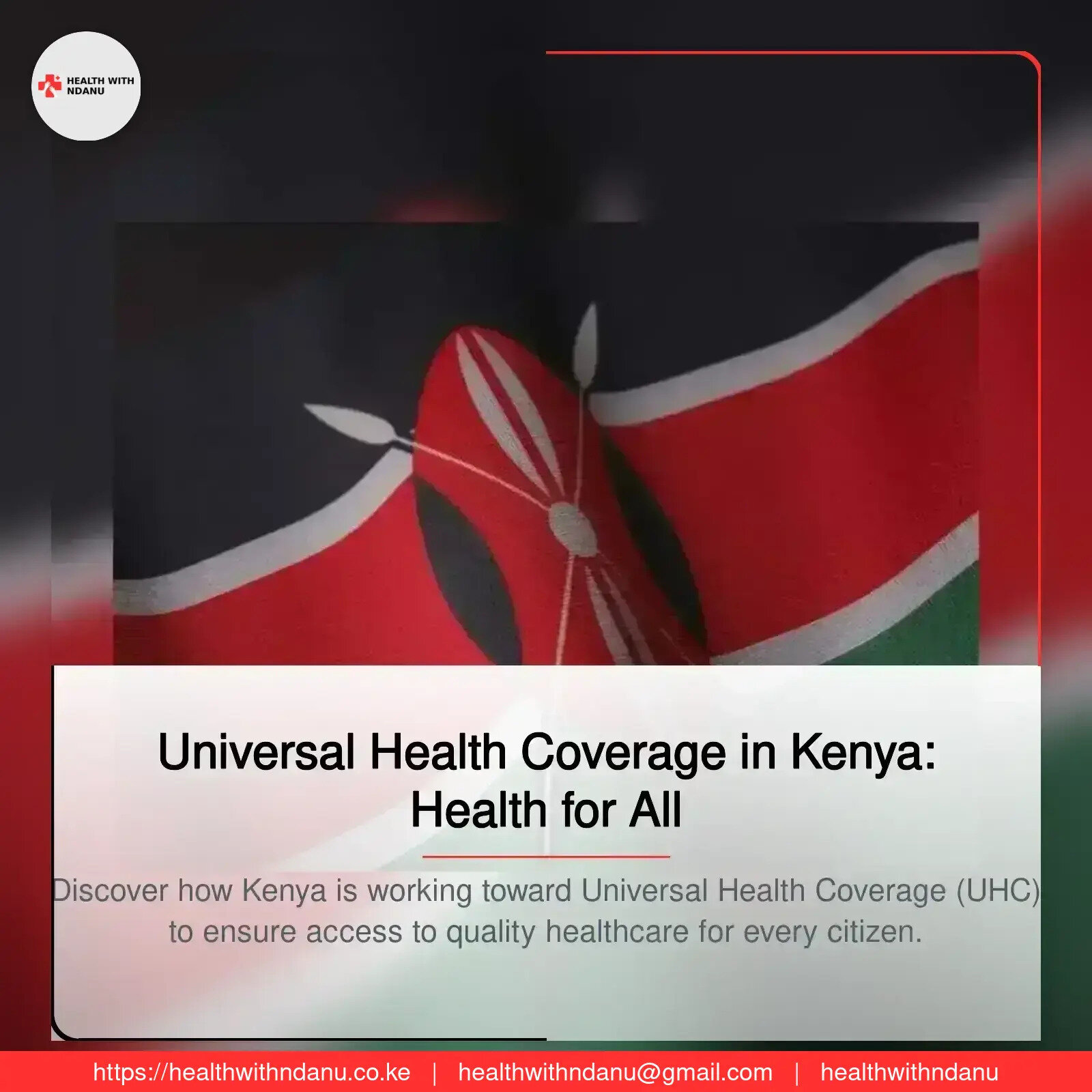Universal Health Coverage in Kenya: Health for All



Introduction
Universal Health Coverage (UHC) is one of the most important objectives in Kenya’s health policy agenda. The concept focuses on ensuring all citizens can access the healthcare services they need without suffering financial hardship. Achieving UHC is critical for improving the quality of life and public health outcomes in Kenya, a nation that faces significant health challenges. UHC is aligned with global goals such as the United Nations' Sustainable Development Goal 3, which seeks to "ensure healthy lives and promote well-being for all at all ages."
In Kenya, UHC was formally integrated into national planning through the Big Four Agenda, one of the administration's key initiatives. As part of this plan, the government aims to extend healthcare services, particularly in rural areas, to marginalized populations that often lack the resources for adequate medical attention. But what exactly does UHC entail, and how has Kenya been working toward this goal?
Why UHC Matters to Kenya
Kenya's health system faces many challenges, including high disease burden, disparities in healthcare access, and the rising costs of medical treatment. Without UHC, a significant portion of the population faces barriers to accessing necessary care, often forcing individuals to choose between healthcare and other basic needs, such as food and shelter. UHC seeks to bridge these gaps, ensuring that every citizen—regardless of their income or location—has access to the necessary medical services.
The importance of UHC cannot be overstated in a country like Kenya, where significant segments of the population are living in poverty, often relying on informal healthcare services or traditional medicine. With UHC, the government is working to ensure that healthcare services are not only affordable but also equitable, reaching rural communities that otherwise have limited access to hospitals or clinics.
The Path to UHC in Kenya: Key Milestones
Kenya's commitment to achieving UHC has been backed by a series of governmental reforms and public health initiatives. Some of the key steps include:
1. The Big Four Agenda: Under President Uhuru Kenyatta, Kenya’s Big Four Agenda prioritized UHC as a key pillar. The initiative focuses on extending medical insurance to more citizens, especially vulnerable groups like the elderly, children, and those living in informal settlements.
2. Expansion of Social Health Assurance(SHA):A central feature of UHC in Kenya is the expansion of SHA & SHIF a government-sponsored health insurance plan aimed at providing affordable healthcare to all Kenyans. By increasing membership and expanding its coverage,SHA aims to reduce the out-of-pocket expenses that many Kenyans face when seeking healthcare.
3. Reforming Healthcare Infrastructure: Another major milestone is the effort to upgrade the country's healthcare infrastructure. This includes upgrading and expanding hospitals, particularly in underserved regions, so that citizens can access quality care close to home. The government is investing in new medical equipment, training health professionals, and improving healthcare delivery systems.
4. Health Sector Devolution: Kenya’s devolution system, introduced in 2013, has played a significant role in improving healthcare delivery by transferring more decision-making power to county governments. This shift allows local leaders to better understand the unique needs of their communities and allocate resources more effectively. However, county governments face challenges such as limited funding and inconsistent implementation of health programs.
Key Components of Universal Health Coverage
UHC is built on three core pillars:
1. Access to Essential Health Services
UHC ensures that all individuals have access to a full range of healthcare services, from preventive care to treatment and rehabilitation. It focuses on services such as maternal health, immunization, treatment of common diseases, emergency care, and chronic disease management.
2. Financial Protection
One of the primary objectives of UHC is to protect individuals from the financial burden of healthcare. Medical bills can be crippling, particularly for those in low-income or rural households. UHC seeks to eliminate the need for individuals to pay out-of-pocket expenses for essential services, thus reducing the risk of catastrophic health spending that can drive people further into poverty.
3. Quality Healthcare
UHC is not only about access to healthcare but also about ensuring the services provided are of good quality. This includes providing services that are safe, effective, and meet the healthcare needs of the population. Quality is measured by factors such as the availability of skilled healthcare professionals, adequate medical equipment, and the effectiveness of treatments.
Challenges to Achieving UHC in Kenya
While the Kenyan government has made significant strides in moving towards UHC, there are numerous challenges to its implementation:
1. Limited Funding
Despite efforts to expand NHIF, funding remains a significant barrier. The government’s allocation to healthcare is often insufficient, and while NHIF aims to provide coverage for all, many Kenyans still find it difficult to afford contributions.
2. Geographical Disparities
While urban areas may have relatively good access to healthcare services, rural areas continue to suffer from limited health facilities, poorly equipped hospitals, and a shortage of medical professionals. In remote areas, patients may need to travel long distances to access treatment, which can be a barrier to timely healthcare.
3. Underdeveloped Infrastructure
Kenya’s healthcare system still suffers from inadequate infrastructure. Many hospitals lack basic equipment and supplies, while health workers are overburdened, with many healthcare centers experiencing high patient loads. These issues compromise the delivery of quality services.
4. Health Worker Shortages
While Kenya produces a significant number of health professionals, there is a shortage of skilled healthcare workers in rural areas. This shortage impacts the quality of services and the ability to deliver consistent care across the country.
5. Cultural and Traditional Barriers
In some communities, there is resistance to modern medical practices, and many people still prefer traditional medicine over formal healthcare. Overcoming these barriers requires comprehensive education and awareness campaigns to shift attitudes and encourage the use of formal healthcare services.
The Role of Community Health Workers (CHWs)
One of the key drivers in achieving UHC in Kenya is the Community Health Worker (CHW) program. CHWs play an essential role in bridging the gap between rural communities and the formal healthcare system. These workers provide basic medical services, health education, and referrals to clinics or hospitals. They are instrumental in promoting preventive health measures like immunization, maternal and child health, and sanitation practices.
Community Health Workers are often the first point of contact for healthcare in rural areas, making them a vital part of the healthcare workforce. They help in areas where healthcare professionals are scarce and ensure that essential services reach the most vulnerable populations.
Conclusion
Universal Health Coverage in Kenya is an ambitious and vital goal that promises to improve the health outcomes and quality of life for millions of Kenyans. However, significant challenges remain, such as funding, infrastructure, and the equitable distribution of healthcare services. By focusing on financial protection, access to quality care, and strengthening the healthcare system, Kenya is working to achieve UHC, with support from initiatives like SHIF & SHA the Big Four Agenda, and the active involvement of Community Health Workers.
As the country progresses on this journey, it is crucial for the government, private sector, and the public to continue working together to ensure that no one is left behind in accessing the care they need.
Una uzoefu wako? Shiriki nasi
Popular Categories
Mablogu Zinazobambwa Sana
Daily Newsletter
Get all the top stories from Blogs to keep track.



